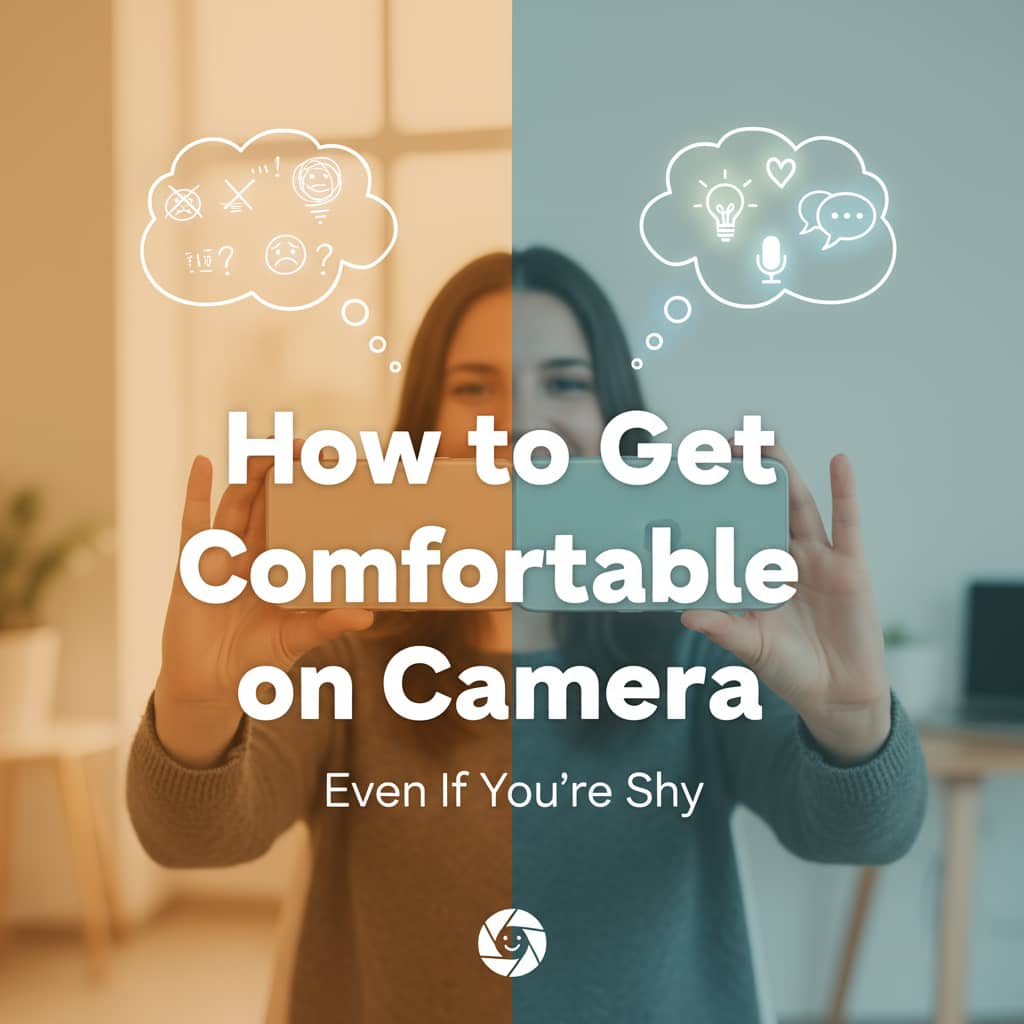Let me tell you something important before we even start: nobody was born “naturally good on camera.” Nobody. Not your favorite YouTuber. Not that TikTok girl with smooth transitions. Not the Instagram guy that talks like he was raised inside a podcast. All of them started rough. Awkward. Stiff like bread that stayed outside too long.
Some people even start worse than rough. They freeze. They blink too much. They stammer. They forget their name. I’ve seen people rehearse one simple line for 30 minutes. I’ve even done worse, I filmed a whole video and didn’t know the camera wasn’t recording. My heartbreak that day could power the national grid.
So if you’re shy or you feel somehow about showing your face on camera, abeg relax. You’re not alone, and nothing is wrong with you. You’re just human.
But here’s the good part: being comfortable on camera is a skill. A learnable one. A very learnable one. And once it clicks, ehn? Your confidence will surprise even you.
So let’s gist. Let me walk you through this thing the same way I wish someone explained it to me: simple, playful, honest, and completely stress-free.

THE FIRST CONFESSION: NOBODY CARES LIKE THAT
This one is the hardest to believe, but it’s true.
That fear you feel like “What if people judge me?” “What if I look stupid?” “What if I make a mistake?” my dear, nobody is watching you that deep.
People are scrolling fast. Attention span is low. Half the time, people are not even listening properly. They’re eating jollof, replying WhatsApp messages, playing with their wig, and watching your video in the corner of their screen. Nobody is analyzing your every blink.
The moment I understood that, my fear dropped like magic. I realized that the person stressing me the most was… me. Not any audience. So start there. Calm down. Stop dragging perfection with yourself. It’s not that deep.
STEP ONE: TALK LIKE YOU’RE GISTING WITH SOMEONE YOU KNOW
Camera fear comes from trying to “perform.” Once you stop performing and start talking like you’re talking to your friend Joy or your guy Chinedu, everything changes. It becomes natural.
Warm.
Comfortable.
Human.
Try this today: put your phone on record and imagine you’re explaining something to one specific friend, not the whole world. Just one person. Even your voice will sound more real. Less forced. Less “presenter mode.” Nobody is looking for a news anchor. They just want you.
STEP TWO: DON’T FILM WHEN YOU’RE TENSE
I used to think I needed to hype myself like a boxer before filming. I would pace. Practice. Repeat lines. Act like I’m entering a battle. That’s a terrible idea.
When you’re tense, your voice becomes weird. Your shoulders rise. Your smile becomes fake. Everything looks forced.
The best videos happen when you’re relaxed.
For some people, that’s early morning. For others, at night when the house is quiet. For some, after eating. For others, after music.
So, you need to find your own flow. Don’t force it. If you’re not calm, don’t hit record.
STEP THREE: LET YOUR FIRST 10 VIDEOS BE “BAD” ON PURPOSE
Your first few videos will embarrass you. It’s normal. It’s part of the process. Think about your first voice note on WhatsApp, didn’t you sound somehow? Now look at you, sending 5-minute VN like podcaster. Growth comes with doing things continuously. Don’t try to make your first videos perfect. Let them be rough. Let them be messy. Let them be “I just started.”
Because once you get comfortable with imperfection, everything becomes easier. You get confident faster because you’re no longer scared of mistakes.mPost the imperfect videos. That’s how improvement starts.
STEP FOUR: USE TOPICS YOU ENJOY
If you want to feel comfortable on camera, stop forcing topics that don’t excite you.
Shyness + boring topic = disaster.
Record things you actually enjoy talking about. Things that make your eyes light up. Things you’ve told your friends a thousand times. Your passion hides your fear. Even if you stumble, people feel your energy. And energy beats perfection any day.
STEP FIVE: START WITH SHORT VIDEOS
Don’t jump into 10-minute YouTube videos if you’re still shaky.
Start with 10 seconds.
Then 20 seconds.
Then 40.
Then 60.
Short videos help you practice without pressure. They build confidence fast because you don’t have to talk long. Once you’re comfortable, you can go longer. It’s better to grow small and steady than to scare yourself and quit.
STEP SIX: KNOW THAT YOU LOOK BETTER THAN YOU THINK
Many shy creators have a problem: they hate how they look or sound on video. Let me say this with love, you’re not seeing yourself correctly. We judge ourselves with harsh eyes. We zoom into flaws nobody else notices. But the same face you’re complaining about is the same face your friends see every day. And they like you. And people online will like you too. So stop focusing on your “bad angle.”
Find your good light.
Smile small.
Talk freely.
You’re fine.
STEP SEVEN: PRACTICE WITHOUT RECORDING
Sometimes the fear comes from the red light on the screen. Once you see “REC,” your brain freezes.
So try this:
Open your camera
Don’t record
Just talk
Act like you’re on a video call
After two minutes, check how you feel. You’ll notice you’re calmer because you’re not thinking about the final result. Do this often and your comfort level will rise faster than you expect.
STEP EIGHT: SCRIPT LESS, OUTLINE MORE
A lot of shy creators make the same mistake: they script every single line. And scripting makes you sound robotic. You begin to focus on lines instead of talking. You start blinking like someone reading exam question 15c.
Instead:
Write 3–5 points
Put them beside your phone
Talk about each one naturally
You’ll sound more human.
More original.
More confident.
And the audience will feel the authenticity.
STEP NINE: RECORD 3–4 TAKE — THEN STOP
Don’t record 20 takes. You’ll just frustrate yourself.
Maximum 3–4 takes.
Even if it’s not perfect, choose the best one and move on. Confidence comes from posting, not over-editing.
STEP TEN: WATCH YOURSELF LIKE A FRIEND, NOT A JUDGE
The most uncomfortable part of being on camera is watching yourself afterwards.
You’ll start spotting mistakes.
You’ll start criticizing.
“Why is my voice like this?”
“Why am I blinking too much?”
“Why is my hand moving like that?”
“Why did I say that nonsense?”
STOP.
Watch the video like someone who likes you.
Like someone who believes in you.
Like someone who knows you’re trying.
Encouragement makes you grow. Self-bashing slows you down.
STEP ELEVEN: USE PROPS IF IT HELPS
Some people feel less awkward when they’re holding something:
- A pen
- A cup
- A microphone
- A notebook
- A product they’re reviewing
It gives your hands something to do.
And it keeps you grounded.
Try it.
STEP TWELVE: LOOK AT THE LENS, NOT THE SCREEN
If you keep looking at your screen, you’ll look uncomfortable. But if you look at the lens, it feels like eye contact.
You’ll connect better.
You’ll look calmer.
Your delivery will improve.
Practice this slowly because it changes everything.
STEP THIRTEEN: FILM IN A PRIVATE PLACE
If people are around, you’ll feel shy 5x more.
Shoot in your room.
Or your car.
Or a quiet corner.
Or anywhere you feel safe.
When you’re alone, you express yourself freely. Even top creators still do this till today.
STEP FOURTEEN: REMEMBER WHY YOU’RE DOING IT
Fear reduces when the purpose becomes stronger.
Why do you want to be on camera?
To share knowledge?
To build a brand?
To help people?
To earn money?
To express creativity?
Keep your “why” in front of you. Confidence grows when purpose is clear.
STEP FIFTEEN: CELEBRATE EVERY SMALL WIN
Did you record one video today?
Celebrate it.
Did you talk for 20 seconds confidently?
That’s a win.
Did you post a video after overthinking?
That’s growth.
Every small win builds your self-belief.
And belief is the fuel of confidence.
THE REAL SECRET: CONFIDENCE COMES FROM EXPOSURE
You don’t become comfortable by thinking. You become comfortable by doing.
The first time will feel weird.
The second time, still weird.
By the seventh time, you’ll notice small improvement.
By the fifteenth time, you won’t even think twice before filming.
Repetition removes fear. Your brain starts seeing it as normal instead of scary.
THE BEAUTY OF IMPERFECT CONFIDENCE
Let me share a gist.
One girl I know used to be painfully shy. Even WhatsApp VN embarrassed her. If she sent you one, she would come back to ask, “Did I sound somehow?”
Last year, she pushed herself to film short TikToks. She wasn’t confident. Her voice shook. She stammered. But she kept posting.
Today, she talks like someone raised inside a restaurant, very loud, confident, expressive. And it wasn’t magic. It was practice.
Your confidence will also grow.
Maybe slowly.
Maybe fast.
But it will grow.
Just don’t quit early.
YOUR SHYNESS IS NOT A PROBLEM — IT’S A FLAVOR
Shy creators are actually some of the most loved.
Why?
Because they feel real.
Soft.
Gentle.
Relatable.
People trust shy people because they come across as honest and thoughtful.
So don’t try to become loud if that’s not your style. Lean into your softness.Your calmness can be your brand.
You don’t have to shout.
You don’t have to perform.
You just have to show up.
A SIMPLE 10-MINUTE PRACTICE ROUTINE
Try this for one week:
Minute 1–2: Breathe. Calm your shoulders.
Minute 3–4: Talk to camera without recording.
Minute 5–6: Record a 20–30 second clip.
Minute 7–8: Watch it gently.
Minute 9–10: Record one more with small improvement.
Do this daily and you’ll improve faster than you expect.
FINAL THOUGHT
You don’t need to be bold to be on camera. You just need to be willing.
Willing to show up.
Willing to look awkward sometimes.
Willing to talk naturally.
Willing to grow in public.
Every confident creator you admire today once felt shy, maybe even worse than you feel now.
But they pushed through. And you can too.
There’s a version of you that speaks clearly.
Smiles freely.
Films comfortably.
Looks straight into the camera with ease.
You just need to practice until you meet that version of yourself. And trust me…
they’re closer than you think.

Leave a Reply